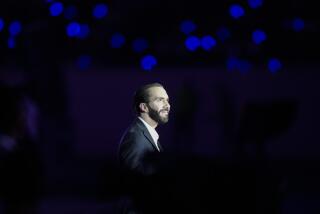‘Cuba’ by Julia E. Sweig
- Share via
Cuba
What Everyone Needs to Know
Julia E. Sweig
Oxford University Press: 304 pp., $16.95 paper
Despite decades of heated rhetoric from Washington and Miami, most of the time Americans don’t give a lot of thought to Cuba. Then, once or twice a decade, some great drama erupts on the island 90 miles off Florida, sending great waves of fear, shock or refugees across the straits to remind Americans of its existence -- until the ruckus dies down and Cuba again fades from U.S. consciousness.
Not so in the reverse, however. For most of Cuba’s history, and certainly since the revolution that brought Fidel Castro’s Communist government to power, U.S. policy has penetrated nearly every facet of life in Cuba, making it virtually impossible for average Cubans to forget about the superpower next door.
This is driven home in “Cuba: What Everyone Needs to Know,” Julia E. Sweig’s forthcoming portrait of the country, where even chapters on domestic issues are as much about Cuba’s relationship with the United States as they are about Cuba itself. Beginning with the Cuban war of independence from Spain through the end of Castro’s rule in 2006, the long arm of the United States has reached across to the island.
For those Americans who have not followed Cuba, or who might start now that the Obama administration has signaled a new beginning in relations between the two countries, this is an excellent and refreshingly evenhanded primer. Part of the Oxford University Press’ “What Everyone Needs to Know” series, it is presented in a question-and-answer format that, while not leaving much room to capture the evocative sights and smells of Cuba or the character of its people, packs a phenomenal amount of complex history into clear and simple prose. It also seeks to explain why the Cuban revolution, battered as it might be, has outlasted the Cold War, nine U.S. presidents and even the decades-long presidency of Castro. Part of the answer lies in Cuba’s defiance of and ability to adapt to U.S. power.
As Sweig tells it, the David-versus-Goliath mentality that is central to Cuban nationalism can be traced back to the writings of Cuban exile and patriot José Martí, who advocated independence from Spain while warning against U.S. interference. Indeed, the United States intervened and, soon after defeating the Spanish in 1898, began a military occupation that was a humiliation to Cubans who had fought for independence. While the occupation ended after the turn of the last century, the U.S. via the Platt Amendment of 1901 limited Cuban sovereignty for decades until a revolt by an obscure Cuban army official, Fulgencio Batista, led to its abolishment. Nonetheless, U.S. companies controlled 40% of the Cuban sugar industry, 50% of its railways and 90% of the telephone and electric services as Batista ruled first behind the scenes and then at the forefront following a military coup in 1952.
Enter Castro. Along with his brother Raúl and a band of 135 insurgents, he launched an armed insurrection on July 26, 1953. The attack on the Moncada army barracks in Santiago de Cuba was a failure that landed the survivors in jail, but they were released in an amnesty a couple of years later and relaunched their insurgency with their Argentine friend Ernesto “Che” Guevara. After just 22 months of fighting, Batista fled and much of the pro-U.S. elite soon followed. Castro rolled into Havana in January 1959.
Sweig argues that Castro’s eventual move into the orbit of the Soviet Union was as much a reaction to U.S. opposition to the Cuban revolution as it was driven by shared ideology. The new regime wanted a redistribution of wealth, which was by definition at the expense of U.S. interests, but it also wanted national independence; instead, the country ended up trading one imperial power for another. It wasn’t always a happy marriage either, as, for example, when Castro’s efforts to wean Cuba of its sugar economy were reversed by Soviet demand for the crop.
Castro created a one-party state that consolidated control of land, the economy and the media in the hands of the Communist Party and government. Limited room for dissent diminished even further in the face of U.S.-backed challenges to the Castro regime, such as the failed 1961 Bay of Pigs invasion and at least eight CIA-backed attempts to assassinate Castro. “For Cuba’s new leaders, the liberal democratic order came to be seen as central to Cuba’s vulnerability to capitalist exploitation and political control by the United States,” Sweig writes.
The worst chapter in the two countries’ relations, the 1962 Cuban missile crisis, brought the world to the brink of nuclear war until, as Sweig notes, the United States and the Soviet Union cut a deal that left Castro fulminating and Cuba watching from the sidelines.
Cuba under Castro was always a little island with big ambitions. Sweig argues that Cuba’s long history of foreign engagements, helping revolutionaries and liberation movements from Africa to Central America, stemmed from the leadership’s own ideology (and perhaps the leader’s own ego) more than from Soviet expansionism. American strategists, she writes, “never really grasped Havana’s capacity to make its own foreign policy decisions.” The collapse of the Soviet Union and the cutoff of subsidies hobbled Cuba’s economy in the early 1990s, causing a period of severe hunger, blackouts and despair, but it also released Cuba from the Soviet hold. Defying predictions, the Castro government survived these hardships by allowing tens of thousands of rafters to flee the island, letting off political steam. But it also survived because the revolution was homegrown. Even amid growing skepticism and frustration, Sweig writes, “many Cubans felt a sense of lasting ownership of their revolution.”
Still trying to relieve the economic pressure, the government eventually legalized possession of American dollars that Cubans received from relatives in the United States. At the same time, Castro resisted further market openings. “Fidel never let anyone forget his profound allergy to the profit, accumulation, avarice, and social inequality inherent in the market,” she writes.
Nor did he let up on dissenters. Even now, with Castro in the wings and Raúl in the presidential palace, Cuba watchers should not expect a radical transformation, Sweig writes. Whatever changes might take place, Cuba “in the short term is unlikely to look like multi-party political democracy in the liberal Western world.”
Miller is an editorial writer at The Times.
More to Read
The biggest entertainment stories
Get our big stories about Hollywood, film, television, music, arts, culture and more right in your inbox as soon as they publish.
You may occasionally receive promotional content from the Los Angeles Times.










